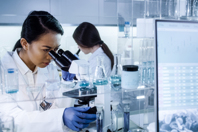Traceability And Compliance: The Keys To A Safe And Efficient Lab
Regulatory compliance and traceability are essential for biopharmaceutical companies to ensure the safety and quality of their products. The pharmaceutical industry is heavily regulated, and companies must adhere to a wide range of laws and regulations in order to remain compliant. Traceability is a crucial component of regulatory compliance, as it allows companies to track the history and movement of their products throughout the supply chain. Having a strong focus on traceability and compliance is key to operating a safe and efficient quality control (QC) lab. This comprehensive list of expert insights, strategies, tools, and techniques for achieving complete traceability and regulatory compliance can help you transform your QC lab.
INSIGHTS on TRACEABILITY AND COMPLIANCE
-
Here, we demonstrate the use of the Supel™ Carbon LC UHPLC column to baseline separate the vitamin D2 and D3 forms from the D2 and D3 epimers.
-
Substitution is the essential starting point in every risk assessment. Learn how to conduct a legally compliant substitution check using real substances as examples.
-
For various industries and materials, exact water determination is necessary. Here, we cover water determination by Karl Fischer titration, the Karl Fischer titration process and methods, quality assurance, and more.
-
Experts explain what a pyrogen is as well as the differences between an endotoxin pyrogen and a non-endotoxin pyrogen. Learn why it is immensely important to detect non-endotoxin pyrogens.
-
Reference materials are a critical component of the analytical testing workflow. Here, we offer information on metrological traceability, the hierarchy of reference materials, fit-for-purpose selection considerations, and more.
-
Tim Sandle, Head of Microbiology at BPL and visiting tutor of the University of College London & University of Manchester, answers questions about pyrogen and endotoxin tests, regulations, and more.
-
Find responses to the 20 most burning questions we received around microbial testing, analytical testing, biologics characterization, vaccines development, dissolution testing, method development, data traceability, regulations, and more.
-
The measurement of pyrogens is an important safety measure for parenterally administered drugs. Here, we explore several advantages the Monocyte Activation Test (MAT) provides over the rabbit pyrogen test.
-
Shift from animal-based pyrogen testing to in vitro testing with the implementation of the only cell-line based pyrogen test that mimics the human immune reaction.
-
In QC, there is still huge potential to accelerate the release of safe products. Here, we review ways to boost the reliability, data integrity, and productivity of microbiological testing.
-
Media fill experts from MilliporeSigma provide an overview of what to consider when selecting media for aseptic process simulations, particularly regarding regulatory requirements and user requirement specification (URS).
-
Microbial risk in pharmaceutical processing cannot be limited to viable microorganisms. Learn how the MAT can help you to assess the pyrogenic risk resulting from your production process.
-
The ability of the Mono-Mac-6 cell line to detect non-endotoxin pyrogens is sometimes questioned. To demonstrate its performance, tests have been performed using a wide panel of monocytic TLRs ligands.
-
The monocyte activation test (MAT) provides an in vitro alternative to conventional animal testing methods. Discover the benefits of a ready-to-use Monocyte Activation Test kit, and examine a real-life case study.
TRACEABILITY AND COMPLIANCE SOLUTIONS
-
Sunken costs, motion waste, and high financial risks of noncompliance are all challenges that QC labs face. Learn about a system that was created to make labs more productive, safe, and compliant.
-
See how LANEXO Inventory Manager works in a lab, and learn about the main features you can use.
-
Three media, Friis, Frey, and Hayflick, are used to detect different ranges of mycoplasmas. MilliporeSigma offers all three as ready-to-use, with longer shelf-life broth and plates for compendial testing.
-
In proteomics and biopharmaceutical research, there is a need to obtain as much information as possible on limited sample amounts. Discover reversed-phase solutions to protein and peptide separation challenges.
-
Pyrogen detection is one of the mandatory release tests for sterile parenteral drugs testing in the course of pharmaceutical quality control. Test methods being used are the rabbit pyrogen test (RPT), the bacterial endotoxin test (or LAL test), and the monocyte activation test (MAT).
-
Performing endotoxin testing? Trust your data with a Monocyte Activation Test that mimics the human immune reaction and detects both endotoxins and non-endotoxin pyrogens.
-
Explore an extensive analytical chemistry and microbial testing compliant portfolio for pharmaceutical analysis and quality control (QC) from early-stage drug development to product release.





















